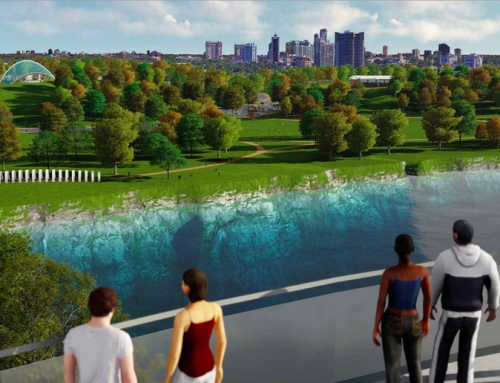Parks are emerging as important public health solutions in urban communities. Nearly 40 years of research evidence confirms that nearby nature, including parks, gardens, the urban forest and green spaces, support human health and wellness. The research about active living and opportunities to avoid chronic diseases (such as diabetes, heart disease and respiratory problems) is particularly relevant to large parks where people can enjoy walking and bike paths, and playing fields. But, equally as important is the role of small parks and nature spaces for health.
In many communities, additional land for large parks is either expensive or difficult to repurpose. Every parcel or easement is ever more valuable. Creating small parks can be a productive public and private joint venture that introduces the spaces for nature encounters that benefit everyone.
Co-Benefits of City Systems
An emerging opportunity for parks and recreation is the integration of green infrastructure and parks goals. Infrastructure systems are planned to systematically source and deliver crucial services or products, such as transportation or water systems. The term “infrastructure” usually brings to mind roads, pipes and power lines. Green infrastructure systems, however, are practical integrations of built and ecological systems that incorporate natural and constructed green spaces to replace or augment traditional gray infrastructure.
Parks and green infrastructure can be co-designed for co-benefits. Parks can serve their primary goals to offer recreation and aesthetic amenities, while also containing spaces that mitigate stormwater or improve air quality. Green infrastructure can achieve essential utility functions in the community, but may also be designed to create the environments that provide nearby nature experiences and support health.
Green infrastructure includes bioswales, rain gardens and other water harvesting features. If a collection of these small nature spaces is to be installed within a community, then a systems outlook is important. The TKF Foundation, a philanthropy dedicated to creating small, high-quality gardens, promotes a “sites-to-systems” outlook so that the sum benefit of small nature spaces is greater than the many parts. Rather than focusing only on the design of individual parcels or features, a broader planning approach could integrate a series of small spaces into a coherent network.
Integrating parks and green infrastructure, co-design for co-benefits: these can be unconventional practices in many public works and parks departments. They are goals that cross the borders of typical policies and purposes. Why is this activity important? Health services costs total nearly 17 percent of the annual U.S. gross domestic product. Creative programs that enable more nature contact in the city can help reduce costs at both the national and community level.
Health Benefits from Small Nature Spaces
Following is a small sample from the research literature of the health benefits gained specifically from small nature spaces:
Improved General Mood and Attitude
A study that compared meditative and athletic walking in forest and indoor settings showed that in both environments meditative walking generated more positive psychological effects than athletic walking. Other investigators have found evidence of lower frustration and increased brain activity, resembling meditation, when moving in green space versus being in retail and commercial areas that have no trees. Also, meditative walking in the forest was the most effective at increasing happiness, defined as the presence of a positive emotional mindset. Psychologists know that being happy broadens how a person thinks about and acts in the daily flow of life’s efforts, creating positive intellectual and psychological resources.
Stress Reduction
Stress is a major contributor to ill health. Left unresolved, long-term stress can lead to immune system issues and illness. The experience of nature is one antidote to stress, and the body’s positive response is remarkably fast, occurring within minutes. Studies by environmental psychologists show that visual exposure to nature, in the form of trees, grass and flowers, can effectively reduce stress, particularly if initial stress levels are high.
Better Mental Health and Functioning
Experiences of nearby nature contribute to better mental health and improve one’s capacity to be productive according to Attention Restoration Theory. Modern life often demands sustained focus on projects, and this effort can lead to cognitive overload, bringing on irritability and an inability to function effectively, often with physical symptoms. Views or brief experiences of nearby nature help to restore the mind from mental fatigue, as natural settings provide respite from the highly focused attention needed for most tasks in school or at work. This may contribute to higher productivity in the workplace, as research shows that office workers with a view of nature are better able to attend to tasks, report fewer illnesses and have higher job satisfaction. Increased time of nature experience (up to 1.5 hours) increases the restorative effect.
Improved Mindfulness and Creativity
Contemporary lifestyles are very busy, and there is a greater need for intentional time-outs to be mindful. Studies of mindfulness workshops, held for both mentally healthy and clinically depressed individuals, show benefits of improved mood, cognitive function and immune response. Nature settings offer sensory inputs that are mentally restorative and can foster ideation. In a study of creative professionals, nature experiences enhanced creativity by evoking new ways of thinking, promoting curiosity and encouraging more flexible thinking. A nature recharge may support creativity, as the restored mind is better at analyzing and developing ideas.
Building Social Capital
Social capital, a critical condition for a host of community benefits, is formed from the interpersonal relationships of people and resulting supportive networks. The mere presence of landscape or trees appears to promote community connections. Views of green space from homes are linked to greater perceptions of well-being and neighborhood satisfaction. Public housing residents reported feeling more safe if their development had well-maintained landscaping, including trees and grass. Greener public housing neighborhoods tend to be safer, with fewer incivilities and less reported crimes. Active involvement in community greening and nature restoration projects also produces social benefits, including strengthening of intergenerational ties and organizational empowerment.
Scientific evidence should be the basis of future efforts to make cities more sustainable and sustaining. We now know that nearby nature — including small plots or parcels imbedded within all land uses — directly contributes to quality human habitat and is profoundly important for the health of mind and body. Integrations of parks and infrastructure goals can provide more opportunities for the nearby nature experiences that promote good health and sustain wellness.




